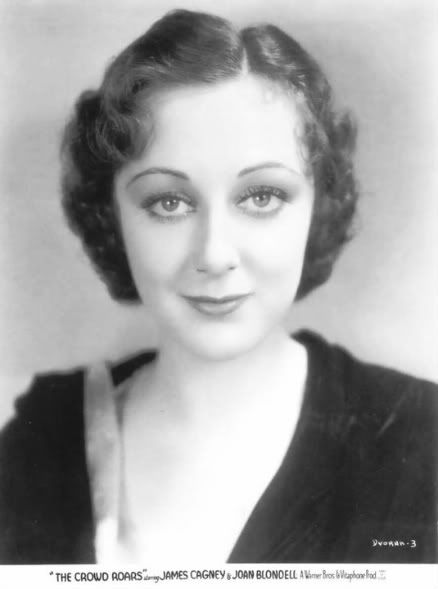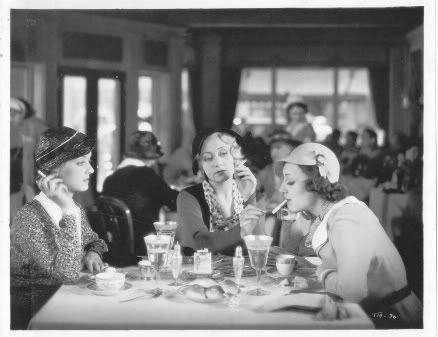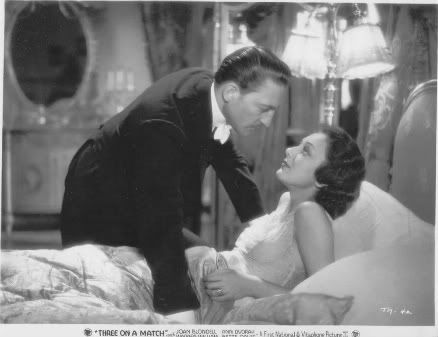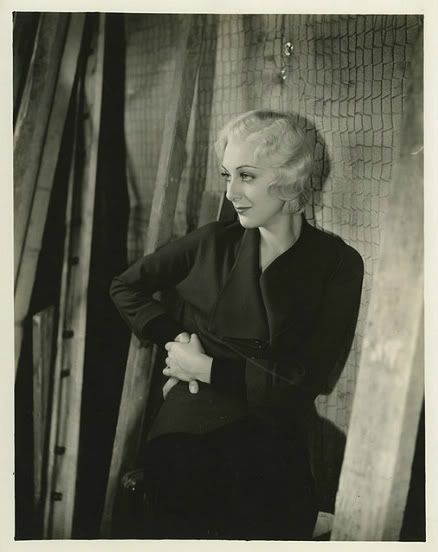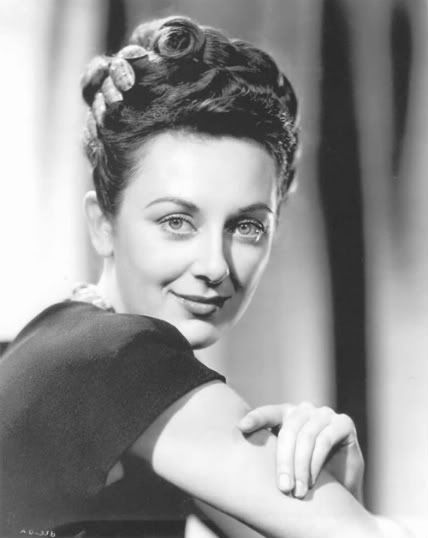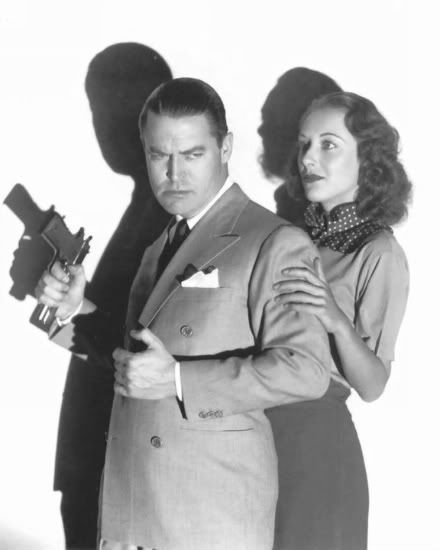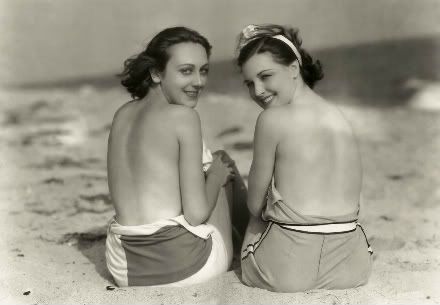Now that your film operator has a main switchboard, I thought I’d go back to earlier days and record what I feel was the turning point of our Classic Film program at the Park Ridge Public Library. Sections of this entry were actually transplanted from an older blog. (Thus, the larger font.) When I hosted the Forbidden Cinema film series at the Library in the spring of 2010, I did not have a blog to chronicle it while it was in progress. That’s unfortunate because the overall experience turned our program into the only place to be on Thursday nights.
It was shortly before my appearance on WBEZ radio when we screened Three On a Match (1932), which turned out to be one of the biggest hits of our Forbidden Cinema series. I feel that’s when we went from being just another library movie program to becoming a community event. That was the moment in which many patrons realized that an obscure movie featuring an obscure actress could be just as powerful as the standard classics they always want to see. Since then, I’ve considered Ann Dvorak my good luck charm.
About a year ago TCM devoted an entire day to Ann Dvorak as part of their “Summer Under the Stars” series. Despite having a 99% capacity on my DVR– 99% full from TCM, of course– I was able to record some of her films like Massacre with Richard Barthelmess and Blind Alley with Chester Morris (pictured below). In primetime, they also showcased what I feel is her best performance as an actress in Three On A Match. I hope many more people have discovered her since.
Our friends at the Northwest Chicago Film Society will be screening an Ann Dvorak film, Heat Lightning (1934), on June 26. The NCFS will have actor Lyle Talbot’s daughter, Margaret, as a special guest prior to the screening. A few years ago the Park Ridge Public Library was honored to have a special contribution from Lyle Talbot’s granddaughter, Caitlin, which we shared with our audience prior to our screening of Three On A Match:
The following is a transcript of my lecture given on April 22, 2010…
* * * * * * *
Tonight’s film takes its title from the World War I superstition that it was unlucky to light three cigarettes using the same match. The idea behind it was that in wartime, lighting three matches would allow enough time for enemy snipers to zero in on the last smoker. The last one to light up would be the first one to die. Since soldiers were actually in trenches during the First World War, it’s more likely this superstition dates back earlier to the 1899 Boer War in South Africa. The film explains that the superstition actually originated with the Swedish match king, Ivar Krueger, who wanted people to use more matches. Truth is, the superstition had already been around when Krueger took credit for inventing it. Either way, back in 1932, audiences would’ve known that the title was a reference to a bad omen. But today, generations removed and superstitions half-forgotten, there are different expectations going in.
This historical reference is pointed out in the film, which recalls recent events through newsreel footage and period music that introduces key years in the characters’ lives. Three On A Match would in fact be the first sound film to look back with a nostalgic eye on the 1920s. If you recognize the Prohibition footage, it’s because it was lifted from 1931’s The Public Enemy.
Tonight’s film is the story of three girls from grade school who reunite years later as young women—each one having taken a different path through life. Joan Blondell plays Mary Keaton, the worst girl in school who is now a showgirl. Bette Davis is Ruth Westcott, a stenographer, and finally, there’s the class beauty, Vivian Revere– now married to a successful lawyer. Vivian is played by Ann Dvorak. The things that make other people happy in life leave her cold. Vivian is the kind of bored housewife who desires things passionately, then after she gets them loses all interest.
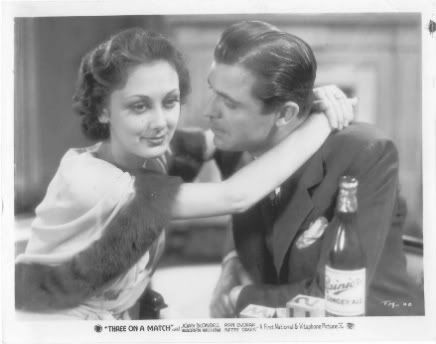
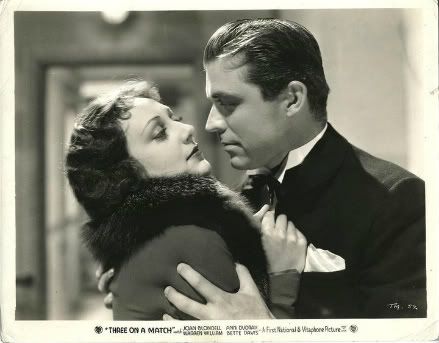
Joan Blondell is her usual wisecracking self, and what movie doesn’t benefit from her presence? She brought pep and personality to every role. She’d become one of the most identifiable stars on the Warner Bros. lot, starring in the great Busby Berkeley musicals such as Gold Diggers of 1933. And unlike our screening of Night Nurse a few weeks back, there are no gratuitous shots of her taking her clothes off. Even at the beach she shows off a rather conservative look… though not quite as conservative as her male co-star, Warren William, who sports a suit and tie under his beach umbrella. Only in the 1930s could you get away with wearing a suit at the beach.
Warren William thrived in the pre-Code era in films like Skyscraper Souls and Employees’ Entrance. He often played a seducer of vulnerable, working-class women. I think of the word “cad” when I think of William, who resembled John Barrymore a little. Warren William played the Sam Spade character in the second version of The Maltese Falcon in 1936 retitled Satan Met a Lady, which also featured Bette Davis. Warren William was the first to play Perry Mason in the movies and also starred as The Lone Wolf and Philo Vance. Off-screen, William was an amateur inventor– creating a prototype of a lawn vacuum that would be used decades later by landscapers. William was a terrific Hollywood villain and a fascinating character to read up on. In this film, though, he has the sympathetic role of the husband, Robert Kirkwood, whose wife is looking for sexual adventure. In that same year of 1932, William would star in a film called The Match King, based on the life of the previously mentioned Ivar Kreuger– the man who played up the ‘three on a match’ superstition in order for people to use more matches.
Of the major players in this film, I thought I’d save the best performance for last. Completing the trio of women, in the role of Vivian, is 20 year old Ann Dvorak—and what an actress she was! She could underplay a scene where lesser actresses might go into hysterics. She had a nervous energy too. She was what pre-Code author Mark Vieira called “a loose wire” of a performer. Ann Dvorak’s name is really pronounced “Vor’ shack”—the D is silent—but she was actually born Annabelle McKim in 1911. As a bit of IMDB trivia, she was a direct descendent of John Caldwell Calhoun, who had served as Vice President of the United States beginning in 1825. She was the daughter of silent star Anna Lehr and actually had appeared in silent films at a very young age. Her father was a director who would leave the family in 1920. They would be separated for fourteen years. She made a motion picture comeback when sound arrived and played various dancers and showgirls in musicals. She was an assistant dance choreographer at MGM where she became friends with Joan Crawford. But it was actress Karen Morley who introduced Ann to Howard Hughes. The famed producer would soon make her a star. Her first real hit was as Paul Muni’s sister in Scarface.
Ann Dvorak in Scarface
In the book Killer Tomatoes: Fifteen Tough Film Dames, written by my friend Laura Wagner, there’s a wonderful chapter on Ann Dvorak that is a must-read for anyone interested in her life. Laura writes about Dvorak’s discovery and the inspiration behind one of Scarface’s most famous pre-Code moments: Dvorak’s provocative dance for the pleasure of George Raft. “But according to Scarface director Howard Hawks, it was George Raft who finally secured Ann’s hiring. The scene was a party at Hawks’ house. ‘Ann asked [Raft] to dance with her but he said he’d rather not,’ Hawks later recalled. ‘She was a little high and right in front of him starts to do this sexy undulating dance, sort of trying to lure him on to dance with her. She was a knockout. She wore a black silk gown almost cut down to her hips. I’m sure that’s all she had on. After a while George couldn’t resist her suggestive dance and in no time they were doing a sensational number which stopped the party.”
Ann Dvorak’s greatest success would come at Warner Brothers where she appeared opposite James Cagney in The Crowd Roars and Douglas Fairbanks, Jr., in Love is a Racket. One of her more noteworthy roles was as the title character in The Strange Love of Molly Louvain. I remember when I ran the LaSalle Bank Theatre revival house I booked 1934’s Heat Lightning with Ann Dvorak. In this little pre-Code gem she’s running a gas station with her sister out in the middle of the desert. It was a precursor to The Petrified Forest (1936).
Ann appeared in many similar programmers for the studio. However, she did not get along too well with the front office. The trouble started early when she discovered she was making the same amount of money as the little boy (Buster Phelps) you’ll see in tonight’s film. In her post-Warners career, Ann Dvorak would freelance. After marrying the British-born actor Leslie Fenton, she moved to England and starred in a few films and even drove an ambulance for the British war effort. Before her retirement in 1951, she appeared in several more films, but she never became a household name– never the big star she might’ve become had she stayed at Warners. Outside of the people in our meeting room, I doubt anyone on the street could name an Ann Dvorak film. But she really is outstanding here, and she’s one of the great underrated actresses in film history.
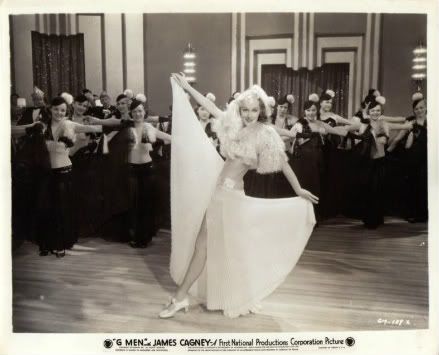
Studio head Jack Warner wrote of Ann, “I had seen her in Scarface, and she had a dainty, unworldly quality that was rare in the actresses around Hollywood at the time. I brought her to Warner Brothers and in a five-year period she made nineteen pictures, including G-Men, Three on a Match, Midnight Alibi, and The Crowd Roars. Almost inevitably, she came down with the temperament disease, and when agents Myron Selznick and Charlie Feldman began double-crossing each other in a fight to get her, Ann ran away and took a slow boat to New York through the Panama Canal. I put her under suspension, and she never came back to the Burbank lot, which was too bad because she had a dazzling future until her quarreling agents snuffed it out.”
The young Vivian is played by Dawn O’Day, who would wisely change her name to Anne Shirley and become a featured star in the 1940s at RKO. Buster Phelps is the exceedingly annoying child actor who plays her neglected son. His cutesy, whiny delivery of his lines did not belong in this film. Film buffs will immediately recognize Lyle Talbot, of course, who plays the gambling playboy Michael. Talbot was a star of dozens of B movies including those made by Ed Wood in the 1950s. In addition, Talbot has the distinction of being the first actor to play both Commissioner Gordon in the serial Batman and Robin and Lex Luthor in the serial Superman vs. the Atom Man. Three On a Match also features brassy blonde Glenda Farrell, as well as character actors Allen Jenkins and Jack LaRue. Edward Arnold is the crime boss, Ace, first seen tweezing his nose hairs in a mirror. And in a small part as the henchman Harve, some bit player named Humphrey Bogart. Not sure what became of him… Frankie Darro, the juvenile delinquent from Wild Boys of the Road, is seen early in the film, and supposedly “Dragnet”’s Jack Webb is there too in his very first movie, somewhere in the schoolyard.
Ann Dvorak in The Strange Love of Molly Louvain
Though Bette Davis called him a hack, director Mervyn LeRoy was anything but. His greatest success in the early 1930s came with the critically-acclaimed I Am a Fugitive From a Chain Gang—one of the socially-conscious films the studio made with a story ripped from the headlines. LeRoy was one of many great directors in the studio stable like William Wellman, Lloyd Bacon, Michael Curtiz, William Dieterle, and Roy Del Ruth, among others. Directors like these could transform standard material into workable formulas. LeRoy makes Three On a Match fast-paced, tense, relevant, and exciting. The film moves, and it’s indicative of the Warner style. There is a gritty, ‘of the streets’ urban realism to it, especially when we have the kidnappers in their hideout, sweating it out as though the image were something out of a pulp story. There are some truly disturbing moments in the film, one of which is memorably set at a park.
LeRoy never made a bomb at the box office, and some of his most popular credits include Little Caesar, Five Star Final, Gold Diggers of 1933, They Won’t Forget, Random Harvest with Ronald Colman, and Thirty Seconds Over Tokyo. And it was as a producer at MGM that he made The Wizard of Oz, directed by Victor Fleming.
Three On a Match was shot by the great cinematographer Sol Polito, who helped define the Warner style with films like I Am a Fugitive From a Chain Gang. Also of note is the title music which was composed by songwriter and conductor Ted Fio Rito, whose compositions would find their way into the Warner Bros. cartoons.
* * * * * * *
For more information, please check out the ultimate site devoted to Ann Dvorak.
With Chester Morris in Blind Alley
With Racquel Torres
